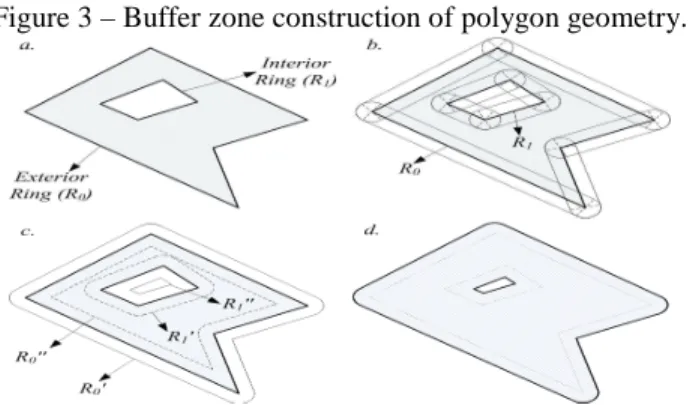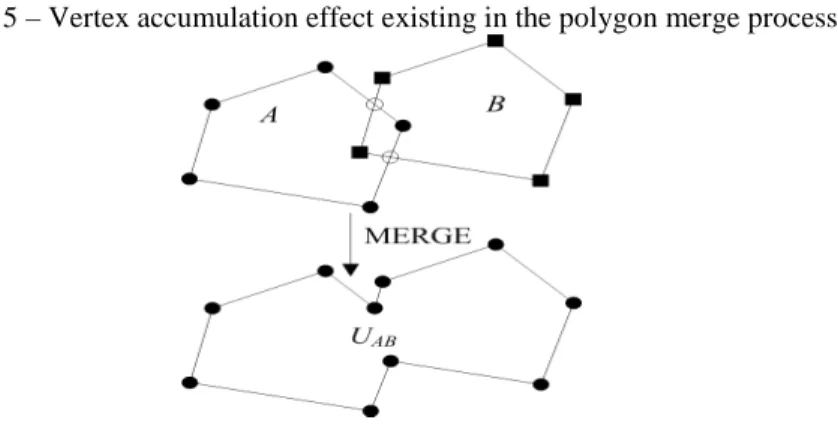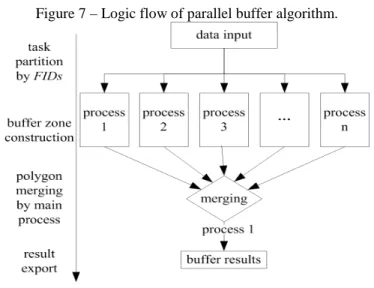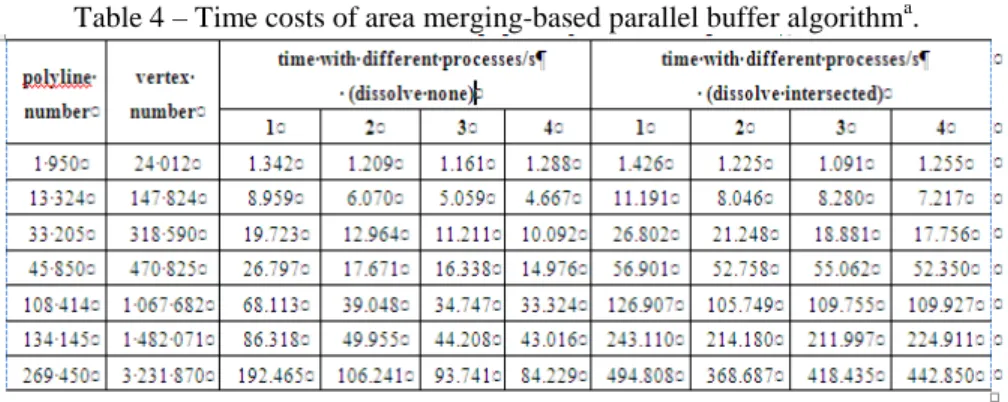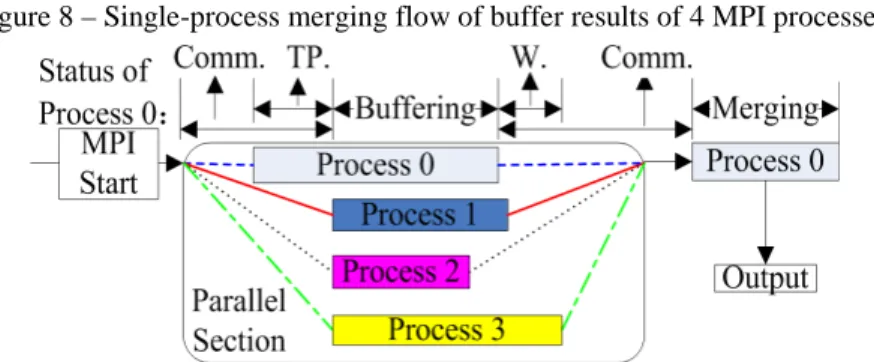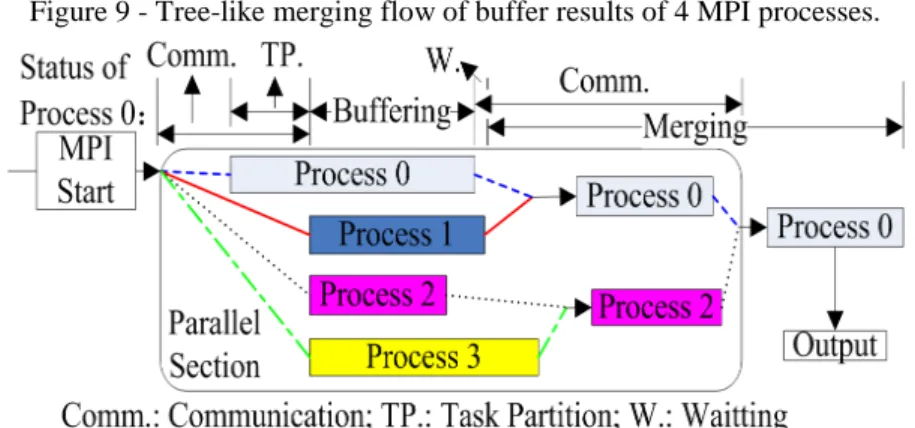http://dx.doi.org/10.1590/S1982-21702014000200015
OPTIMIZATION APPROACHES TO MPI AND AREA
MERGING-BASED PARALLEL BUFFER ALGORITHM
Estratégias de otimização de algoritmos de armazenamento paralelo baseados em fusão de área e MPI
JUNFU FAN1, 2, 3 MIN JI4(1) GUOMIN GU5
YONG SUN4
1State Key Laboratory of Resources and Environmental Information System, Institute of Geographic and Nature Resources Research, Chinese Academy of
Sciences, Beijing 100101, China
2University of Chinese Academy of Sciences, Beijing 100049, China 3School of Architectural Engineering, Shandong University of Technology, Zibo
255049, China
4College of geomatics, Shandong University of Science and Technology, Qingdao 266510, China
5Computer Science and Technology College, Zhejiang University of Technology, Hangzhou 310023, China
fanjf@lreis.ac.cn ; jamesjimin@126.com
ABSTRACT
On buffer zone construction, the rasterization-based dilation method inevitably introduces errors, and the double-sided parallel line method involves a series of complex operations. In this paper, we proposed a parallel buffer algorithm based on area merging and MPI (Message Passing Interface) to improve the performances of buffer analyses on processing large datasets. Experimental results reveal that there are three major performance bottlenecks which significantly impact the serial and parallel buffer construction efficiencies, including the area merging strategy, the task load balance method and the MPI inter-process results merging strategy. Corresponding optimization approaches involving tree-like area merging strategy,
the vertex number oriented parallel task partition method and the inter-process results merging strategy were suggested to overcome these bottlenecks. Experiments were carried out to examine the performance efficiency of the optimized parallel algorithm. The estimation results suggested that the optimization approaches could provide high performance and processing ability for buffer construction in a cluster parallel environment. Our method could provide insights into the parallelization of spatial analysis algorithm.
Keywords: Area Merging; Parallel Buffer; Task Partition; Vertex Accumulation
Effect; Tree-like Merging; MPI.
RESUMO
Na construção de uma área de influência, o método de dilatação baseada em rasterização inevitavelmente introduz erros, e o método de dupla linha paralela envolve uma série de operações complexas. Neste artigo, propõe-se um algoritmo de armazenamento paralelo baseado na fusão de área e MPI (Interface de transferência de Mensagem) para melhorar o desempenho de análise de armazenamento, no processamento de grandes conjuntos de dados. Os resultados experimentais revelam que há três grandes gargalos de desempenho que impactam significativamente a eficiência de construção de armazenamentos seriais e paralelos, incluindo a estratégia de fusão de área, a tarefa / método do balanceamento de carga e os MPI resultantes da estratégia de fusão. Para superar esses gargalos, são sugeridas abordagens de correspondência de otimização envolvendo a estratégia de fusão em árvore, um método orientado de partição do número de vértices em tarefas paralelas e uma estratégia de fusão dos inter-processos. Os experimentos foram realizados para examinar a eficiência do algoritmo paralelo de otimização. Os resultados estimados sugerem que as abordagens de otimização podem fornecer alto desempenho e capacidade de processamento para a construção de armazenamento em um ambiente paralelo agrupado. Esse método pode fornecer sugestões sobre a paralelização de algoritmos de análise espacial.
Palavras-chave: Fusão de Área; Armazenamento Paralelo; Tarefa de Partição;
Efeito de acumulação de Vérices; Fusão em Árvore; MPI.
1. INTRODUCTION
2009; McKENNEY et al., 2011), which all depend on the paradigm of parallelism (BARNEY, 2012). In a cluster computing environment, most of proposed parallelized spatial analytical algorithms are based on the framework of the message passing interface (MPI). The two major modes for the realization of parallel computation are data decomposition and task partition (GRAMA et al., 2003), which correspond to spatial data division and pipeline parallel processing, respectively. Data division strategies for parallel spatial analysis algorithms with topological relations have been extensively discussed (SLOAN et al., 1999; MINETER and DOWERS, 1999; DARLING et al., 2000). For instance, a parallel task partition approach based on the partition of geometries has been designed and implemented (MINETER and DOWERS, 2000), and an idea of software stratifying at a low level has been proposed to encapsulate the complexity and reuse the codes of parallel algorithms (MINETER and DOWERS, 2000). Furthermore, Mineter (2003) presented a parallel vector spatial analysis platform called the TSO (Topology-Stitching-Output) software framework. This approach were based on the NTF data model, containing topological information allowing complex topology to be created and checked in parallel task partition and result sewing. However, the processing and maintenance of topological information are time consuming for large dataset.
In GIS (Geographical Information System), a buffer is defined as a zone around a map feature measured in units of distance or time (ESRI, 2013). As an important function in map information retrieval, comprehensive spatial analysis, and processing in GIS, buffer analysis solves the problem of proximity and represents an influence extent or service extent (WU, 1997). Buffer analysis algorithm is widely used in many geo-spatial fields, such as spatial data query, hybrid overlay analysis of vector and raster data, thematic mapping, and so on.
result in many errors. In research and engineering applications, buffer analysis algorithms also face efficiency limitations caused by large dataset.
Area merging can be achieved through polygon clipping algorithms, which have been intensively studied, and many algorithms have been proposed (SUTHERLAND and HODGMAN, 1974; WEILER and ATHERTON, 1977; LIANG and BARSKY, 1983). The currently recognized efficient algorithms that can process arbitrary polygon clipping within a limited amount of time include Vatti's algorithm (VATTI, 1992) and Greiner-Hormann’s algorithm (GREINER and HORMANN, 1998), which with similar performances. The Vatti’s algorithm supports clipping between polygons with any number of edges and in any shape (e.g., self-intersection with islands and/or holes). Murta (1998) then modified Vatti's algorithm to overcome the problem that horizontal edges could not be processed properly. Based on Vatti's algorithm, we implemented area merging and avoided its performance bottleneck by using a divide-and-conquer method. Moreover, area merging was introduced into the buffer creation to replace the complex ring construction and spatial relationship processing. Thus, the buffer creation algorithm was simplified, and a parallel buffer analytical algorithm was implemented.
At present, there is little research on optimization approaches to parallel buffer algorithms under high-performance computation, and the buffer analytical tools provided by GIS software do not have satisfactory efficiency. Therefore, it is valuable to further explore and discuss parallel buffer algorithms and their optimization approaches under the background of big data. Firstly, a serial buffer construction algorithm based on area merging was proposed, and an optimization approach based on area merging and the divide-and-conquer method was proposed. The efficiencies of the optimized algorithm and ArcGISTM Buffer tool were compared with or without dissolving of the buffer result polygons. Secondly, a parallel buffer analysis algorithm was developed on the basis of data parallelism, and its accelerating abilities under the above two conditions were analyzed. Thirdly, the operation of the parallel buffer analysis algorithm was analyzed to identify the possible performance bottlenecks, and corresponding optimization solutions were then proposed.
In this paper, the experiments were performed under the same hardware conditions. The results showed that the buffer creation algorithm based on area merging and optimized using the divide-and-conquer method was feasible and had some advantages over the general buffer algorithm. The optimized algorithm effectively improved efficiencies in buffer creation and result dissolving, and an ideal speedup ratio was obtained. Therefore, the optimizing approaches are feasible pathway to improve area merging-based serial and parallel buffer algorithms.
2. AREA-MERGING BASED BUFFER ALGORITHM
comparison experiments between our serial buffer algorithm and the ArcGISTM buffer tool are conducted. The vertex accumulation effect and the optimization solution to it in the process of polygon merging will be discussed in this section too.
2.1 Construction of Buffering Zone
Buffer creation algorithms based on vector geometry are generally implemented through the following steps: creation of parallel lines, construction of rings, and processing of spatial relationships between intersected rings. The latter two steps involve numerous complex numerical computations (e.g., intersection calculation, vector computation, identification of included angles, and processing of self-intersection). These two steps may hardly be realized owing to many types of special cases should be handled. Therefore, we proposed a new method to replace these two steps for simplification of buffer creation by introducing the mature polygon clipping algorithm into vector buffer construction. Vatti's algorithm supports the polygon clipping operation and boolean operations (e.g., union and difference) in polygon overlay, so it is recognized as being able to process arbitrary polygon overlay within a limited time. In this study, area merging was realized on the basis of Vatti's algorithm. With the area merging approach, an unilateral buffer can be easily realized, and an asymmetric buffer can be realized using bilateral distinction and endpoint arc center translation. In this paper, only the most typical bilateral and symmetric buffer was discussed. The buffer creation algorithm based on area merging for the three basic types of geometries (point, polyline and polygon) is described as below:
(1) - For point object, when the radius (r) of a buffer is known, the buffer creation and construction methods for a point are the simplest because users can only draw an end-to-end ring with P0 as the center and r as the radius. A point (P(x,y)) on the
ring and the center (P0(xP,yP)) satisfy the following equation:
(
) (
2)
2 2P P
x
−
x
+
y
−
y
=
r
(1) A point on the ring can be computed from Eq. (1), and the points are connected one-by-one to form a closed ring, namely a buffer zone with P0 as the center and r as theradius (Figure 1-(a)). For a multi-point geometry, the results may be overlapped if the buffer of each point is created as per the rule for point geometry (Figure 1-(b)). Area merging can then be called to dissolve the overlapped areas, and the final result is shown in Figure 1-(c).
(2) - For polyline object, polyline geometry can be regarded as a group of end-to-end segments, and each segment is composed of a starting point and an end-to-ending point. Figure 2-(a) shows that the buffer for segment L is created in 3 steps as follows: 1) find L's two parallel lines (Lleft and Lright) at two sides and with a distance
of r; 2) draw two semi-arcs (Cs and Ce) with the starting point (Ps) and the end point
(Pe) as the center, respectively; and 3) connect Lleft, Cs, Lright, and Ce successively to
construct a polygon (Figure 2-(c)), namely a buffer zone of segment L with r as the radius. If a polyline consisted of several segments (Figure 2-(b)), area merging will be used to dissolve all segment buffer zones to form a final buffer polygon result for it (Figure 2-(d)). A linear geometry composed of several independent polylines is called a multi-polyline, and its buffer zone can be created by dissolving the buffer zones of all its polylines.
Figure 2 – Buffer of polyline geometry.
(3) - For polygon object, a polygon denotes a plane-shaped area enclosed by a group of closed polylines. As shown in Figure 3-(a), an enclosed polyline is also called a ring, which can be divided into an interior ring and an exterior ring according to the strike of the points constituting the ring. A simple polygon only contains one exterior ring and several interior rings, and a polygon that contains several exterior rings is called a multi-polygon. Buffer creation based on area merging for a simple polygon includes the following steps: decomposition, ring construction, dissolving, and deletion. First, the rings of a polygon are decomposed into a group of polylines, and independent buffer polygons are then constructed for each polyline as per the method in Figure 2. The polyline buffers are then dissolved, and the rings are selected and deleted. For instance, in creation of a bilateral buffer, the rules are as follows: the exterior ring created from the input polygon’s exterior ring is reserved; the interior ring created from the polygon’s interior ring is reserved; and other rings are deleted. Figure 3-(b) shows that the input polygon was composed of an exterior ring (R0) and an interior ring (R1), and all of the rings were split up at the starting
algorithm for polyline resulting in 4 rings (R0’, R0’’, R1’ and R1’’) (Figure 3-(c)).
Based on the conservation rule for result buffer polygon rings, the R0’ exterior ring
created from the R0 exterior ring as well as the R1’’ interior ring created from the R1
interior ring were conserved, while R0’’ and R1’ were deleted. Finally, a result
polygon was created as indicted by the shadow-filled region enclosed by the real line (Figure 3-(d)). The buffer of a multi-polygon can be created by dissolving the buffers of simple polygons. In creation of the interior ring's inside buffer, the buffer's radius exceeded the buffer range that the interior ring could hold if the buffer polygon's interior ring disappeared after dissolving, so all rings created from this interior ring should be discarded. The buffer created from an interior ring will never surpass the buffer created from the exterior ring that contains it.
Figure 3 – Buffer zone construction of polygon geometry.
2.2 Divide-and-Conquer Method for Area Merging
In this study, the widely validated Vatti's algorithm was used for area merging, and the time costs relation in area merging were statistically analyzed with different data volumes. Table 1 shows that the time cost of the UNION operation of Vatti's algorithm increased with the increasing number of polygons, but the performance was unsatisfactory. Thus, we statistically analyzed how the time cost in a single UNION operation changed with the increasing number of vertices, and regression analysis was also used.
Table 1 – Time costs of polygon merging implemented by Vatti’s algorithm.
polygon number merging time/s
400 3.283
2 000 135.198
4 000 1 650.110
6 000 4 727.272
8 000 7 034.313
With the increasing number of vertices, Figure 4 shows that the Vatti's algorithm showed a rapid growth similar to the power function. In dissolving a polygon set, we used a one-by-one ‘snowball’ strategy. With the progression of dissolving, the number of vertices contained in the polygons in each operation would inevitably be increased in most cases. In Figure 5, UAB is the dissolved result
from polygons A and B, and the number of vertices in UAB was obviously larger than
that of B or A. When Vatti's algorithm is used, UAB will consume more time than A
and B, which is called the vertex accumulation effect in area merging and is the major cause of the low efficiency shown in Table 1.
Figure 4 – Fitting curve of time costs of UNION operator of Vatti’s algorithm.
Figure 5 – Vertex accumulation effect existing in the polygon merge process.
recursively solved, and their results were conquered to obtain the solution to the original problem (Thomas et al., 2011). This method is the foundation for many efficient algorithms, such as sorting algorithms (fast sorting and merge sorting), and the Fast Fourier Transform (FFT). The divide-and-conquer method has long been applied to solving geo-spatial problems, such as the divide-and-conquer algorithm for finding the closest point pairs proposed by Bentley and Shamos (1976) and the improved algorithm in calculation of the Delaunay triangular network based on the plane point set in the divide-and-conquer method (Dwyer, 1987). Under recursive mode, each recurring operation contains three steps as follows: divide, solve, and dissolve. The final result of area merging is not related to the internal dissolving order of the polygon set. Though the divide-and-conquer method is used mainly in recursive problems, it can also be used to dissolve a polygon set with a fixed number of polygons because the process and target of dissolving are explicit.
Figure 6 – Process of tree-like merging of polygons.
In tree-like merging, the polygons are first paired and dissolved, and the results of two adjacent pairs are then dissolved until only one polygon remains. Compared to ‘snowball’ merging, tree-like merging does not increase (or reduce) the number of calls of the UNION operator, but it accelerates computation by successfully avoiding the vertex cumulative effect. The data in Table 1 were also used for tree-like merging, and the statistics of time costs are listed in Table 2.
Table 2 – Time costs of tree-like merging of polygons.
polygon number dissolving time/s
400 0.140
2 000 0.796
4 000 2.824
6 000 6.053
8 000 10.234
Tree-like merging showed obvious efficiency improvement because it effectively reduced the average number of vertices contained in the polygons in each function call of the UNION operator and, thus, successfully avoided the vertex accumulation effect hidden in the process of polygon set dissolving. The tree-like merging method was not only used in the creation of the single feature buffer polygon but also in the dissolving of intersected multi-feature buffer polygons.
2.3 Performance Analysis of Serial Algorithm
For the three major types of geometries of point, polyline, and polygon, the proposed algorithm was most representative in processing polyline geometries. To analyze the performances of the serial buffer algorithm with different data volumes, relevant experiments were conducted using real road network polyline datasets, and comparisons to the serial Buffer tool of ArcGISTM 9.3/10.1 SP1 software on the same hardware platform were made.
Table 3 shows that when the intersected multi-feature buffer result polygons were not dissolved, the proposed algorithm showed a lower efficiency (0.7-1 lower) than the ArcGISTM buffer tool. However, if the buffer result polygons were dissolved, ArcGISTM 10.1 SP1 failed even after more than 10 h. Although some results were achieved by ArcGISTM 9.3, the time cost was considerably greater than the proposed algorithm, and the proposed algorithm was more efficient with the increase of data volume. Therefore, the algorithm proposed in this study was feasible and could effectively overcome the severe performance bottleneck faced by GIS software during buffer analysis and result dissolving.
Table 3 – Time costs of serial polygon merging based buffer algorithm. a
a
Experiments were carried out on Windows 7 Ultimate (x64).
b ArcGISTM 10.1 with SP1 and background geo-processing switched off. c Task did not get results within 10 hours and was canceled.
Some abnormalities were observed during the experiments. In ArcGISTM 10.1, when the Parallel Processing Factors under ArcToolBox were set as 0, 1 or below 10% and when the created buffer result polygons were not dissolved, the CPU utilization rate of the Buffer tool was still maintained at 25-27%, but this rate was only 12% in the proposed algorithm. The computer's CPU was an Intel i7-2600, which is a quad-core CPU with hyper-threading function. In general, multiple
polyline number
vertex number
time/s (merge none) time/s (merge intersected)
our alg. ArcGIS
TM
9.3/10.1b our alg.
ArcGISTM 9.3/10.1
1 950 24 012 1.030 <1/<1 1.677 10.50/42.00
13 324 147 824 6.911 4.00/3.67 13.291 189.00/2 053.00
33 205 318 590 14.547 9.33/7.60 32.098 787.00/—c
45 850 470 825 21.544 13.67/10.50 57.885 1 243.50/—
physical or virtual cores were engaged in computation when the CPU utilization rate was greater than 12%. Thus, ArcGISTM might conduct hyper-threading optimization or multi-core parallelization and optimization for its Buffer tool codes, which also explained why the proposed algorithm showed approximately doubled time costs compared to the ArcGISTM buffer tool.
3. PARALLEL BUFFER ALGORITHM BASED ON MPI
The logical flow of the parallel buffer algorithm based on MPI will be described and the performance of the parallel algorithm will be studied by conducting of some parallel experiments in detail in this section. Experiments results reveal that the task load balancing and MPI inter-process results merging methods are two main bottlenecks of the parallel buffer algorithm.
3.1 Logical Flow of Parallel Buffer Algorithm
In practices, buffer analysis tools also face the challenge of large data volumes. Therefore, it is necessary to use high performance computation technology to design a parallel buffer algorithm and to study its optimization algorithms to overcome the problem of massive data in buffer analysis. The logic flow of parallel buffer analysis algorithms includes the following 4 stages: task division, parallelization to create buffer polygons, buffer area merging, and output of result data. These tasks correspond to decompose, compute, dissolve, and output in Figure 7.
Figure 7 – Logic flow of parallel buffer algorithm.
first three steps are the core of parallel buffer analysis algorithms, and the optimization of the proposed algorithm was discussed considering these three aspects. Data output may involve several detail conditions of application environments (e.g., vector data model, parallel file system, and parallel database). These detail conditions are largely different from each other and are not the core procedures in the parallel buffer analysis algorithm. These conditions consume little time compared with other steps; therefore, they were not discussed in this paper.
3.2 Performance Analysis of Parallel Buffer Algorithm
Based on the above logic flow, a parallel buffer analysis algorithm was implemented on the basis of the MPI program model and data parallelism, and it was tested using data of several groups of real linear road networks. Table 4 shows that the proposed algorithm could improve efficiency to a certain level. When buffer result polygons were not dissolved, the 4-process parallel computation could achieve efficiency as high as that of ArcGISTM. However, MPI and data parallelism did not bring buffer analysis algorithms with an ideal speedup ratio. With increased processes, parallel computation efficiency was reduced, indicating that parallel algorithms based on plain parallelism could be optimized further, which suggested that its bottleneck should be analyzed carefully and eliminated
Table 4 – Time costs of area merging-based parallel buffer algorithma.
3.3 Bottlenecks of Parallel Buffer Algorithm
analyzed the time costs for the two procedures of buffer zone generation and dissolving with the largest velocity difference.
Table 5 shows that the numbers of features were evenly distributed among MPI processes and that certain parallel acceleration was achieved, but the numbers of vertices contained in the vector features were different among processes.
Table 5 – Differences of time costs between MPI processes (data partition by FIDs).
process /feature number
speed
time costs of single process/s
data volume of single process
buffering tree-like merging
feature number
vertex number
4/134 145 fastest 9.284 9.073 33 536 256 908 slowest 20.150 57.449 33 537 492 465
8/269 450 fastest 21.491 7.833 33 681 313 627 slowest 37.772 91.226 33 683 547 461
The area merging based on Vatti's algorithm was sensitive to the number of vertices, and the buffer algorithm based on this operation was inevitably affected, which would cause large computation time differences among processes. The slowest process had a time cost that was 2.2 times that of the fastest process and a dissolving time that was 11.6 times that of the fastest one. Unreasonable data decomposition would result in a potential performance bottleneck for MPI algorithms; therefore, the premise for MPI inter-process load balance was to homogeneously decompose the parallel tasks under data parallelism mode, which is also an important direction for the optimization of parallel algorithms.
4. APPROACHES TO OPTIMIZING THE PARALLEL BUFFER ALGORITHM
To overcome the bottlenecks introduced in section 3, a vertex amount-based parallel task partition strategy and a tree-like inter-process results merging method are proposed and described in this section.
4.1 Parallel Task Partition
The most straightforward method to process vector spatial data based on a simple feature model is to realize a parallel task partition through dataset division by the number of features. The principle of this method is easy. Suppose that the input data have F features and that a parallel environment contains n MPI processes, the number (m) of features that are distributed to each process are as follows when based on data decomposition:
/
m
=
F n
Orm
=
F n
/
(2)This method can obtain uniform results when the dataset has uniform features, but this situation rarely occurs. Furthermore, the low level algorithm is sensitive to the volume of vertices holding the features, not to the number of features. In most cases, this method cannot obtain load balance; therefore, new data decomposition methods should be developed.
In response to this defect, we proposed a parallel task data decomposition method based on vertex number statistics because the UNION operator for parallel vector buffer results is sensitive to the number of vertices in polygons. For data decomposition, this method depends on the number of vertices contained in geometries. Suppose that a group of input data contains N vertices and a parallel environment contains n MPI processes, then each process is expected to be assigned with a group of vector features with P vertices as follows:
/
P
=
N n
(3)The number of features distributed into a process is no longer constant. However, the geometries cannot be split, and the total number of vertices Pi
was divided based on the number of features and on the number of vertices. The contradistinction experimental results are listed in Table 6.
In Table 6, TFIDs is the total time costs of parallel computation based on the
number of features, and Tpoints is the total time costs of parallel computation based
on the number of vertices. Moreover, TDP is the time cost in data division based on
the number of vertices, which is already contained in Tpoints.
Table 6 – Improvements by the method of point number-based data partition.
feature/point number time costs (4 MPI processes)T/s
TFIDs Tpoints TDP
13 324/147 824 7.517 6.558 0.042
18 154/215 048 14.043 11.618 0.101
33 205/318 590 18.267 15.594 0.103
45 850/470 825 52.023 46.478 0.142
108 414/1 067 682 110.365 101.155 0.396 134 145/1 482 071 224.633 204.446 0.429 269 450/3 231 870 430.176 419.370 1.379
The results indicate that the partition method based on the number of vertices achieved a 10% higher performance at the expense of a 0.43% time consumption increase. Therefore, this method can improve computation efficiency for the parallel vector buffer algorithm.
4.2 Tree-Like Merging Between MPI Processes
When several parallel MPI processes are finished, the polygon result sets derived from all processes should also be determined for intersection and be dissolved. A simple method is to distribute all results to a single process (e.g., the main process shown in Figure 7) for area merging and output. The operation flow of this method is shown in Figure 8.
One evident defect of this method is that the single process responsible for results merging has to wait until all processes are finished to continue and finish the final merge process. Regarding the significant effect of tree-like merging, we proposed to design a new strategy for merging inter-process result sets, which accelerates computation by decreasing the inter-process waiting time. This process was called the MPI inter-process tree-like merging optimization strategy, and its work flow is shown in Figure 9.
Figure 9 - Tree-like merging flow of buffer results of 4 MPI processes.
With the 4 MPI processes in Figure 9 as an example, the result will be preserved and processed by the 1st process when the 1st and 2nd processes are merged. When the 3rd and 4th processes are merged, the result will be preserved and processed by the 3rd process, followed by the results of the 1st and 3rd processes being merged again. In this way, the difficulty of developing the MPI program can be reduced by providing a tree-like merging pathway for predesigned MPI parallel processes. The parallel buffer algorithm with the above merging flow was implemented to compare the parallel buffer algorithm with a single process merging strategy. Seven groups of road network data with different data volumes were used, and the other characteristics were kept constant.
Table 7 – Time costs of parallel buffer algorithm optimized by tree-like merge strategy between MPI processes.
The optimization of the MPI inter-process tree-like merging can still be improved. For instance, the merging order is not preset, but a ‘first finish first merge’ mode is used. An evolution coefficient can be defined for each process, and the two earliest finishing processes are merged first. After each merging process, the evolution coefficient of one process is added by 1, and the other process is ended. In each merging step, only the processes with the same evolution coefficient are merged, unless the number of processes marked by a certain evolution coefficient is only 1. After all processes are merged, the results are finally merged and output by the process with the highest evolution coefficient. However, this method would greatly increase the complexity of inter-process communication and programming. Thus, this method would significantly increase the difficulty for developing MPI parallel programs; therefore, appropriate selection and rejection are necessary in practical applications, which should be further studied.
5. CONCLUSIONS AND FUTURE ISSUES
In this paper, a vector buffer generation algorithm based on the traditional segment buffer zone construction algorithm and the area merging approach was proposed. The algorithm simplified the process of buffer zone construction by introducing a mature polygon clipping algorithm to dissolve the buffer results of a single feature or several features, and the processing of complex spatial relationships during feature buffer creation was avoided. Moreover, the code complexity and coupling degree were reduced. For optimization of the buffer result dissolving, a divide-and-conquer method was used to overcome the bottleneck of the vertex accumulation effect in serial buffer algorithms. The efficiency of this method was lower than that of mature commercial GIS software when the buffer results of different features were not dissolved, but numerous experiments revealed that this method could finish buffer construction for a massive dataset with arbitrary geometries in a reasonable amount of time. In creating intersected buffer zones that should be dissolved, the proposed algorithm was far more efficient in serial computation than the ArcGISTM Buffer tool. Therefore, this buffer creation algorithm based on area merging has certain practical values.
Parallel computation is a feasible way to overcome the problem of increasingly larger spatial data volumes. Though the development of parallel algorithms is important, their optimization is also important for accelerating computation and scaling up the problems to be solved. In this paper, parallel buffer construction and a dissolving algorithm were implemented on the basis of a serial buffer algorithm and the MPI parallel programming model. We elaborated the two possible performance bottlenecks in the parallel buffer algorithm that caused low efficiency, and we proposed specific solutions, including the parallel task partition approach based on the number of vertices for parallel task load equilibrium and the tree-like merging approach to MPI inter-process result polygon sets. In the case of 4 MPI processes, the results showed that the new parallel task partition strategy improved performance by 10% at a 0.43% time cost increase. Moreover, the inter-process tree-like merging method improved efficiency by 46.6%, and the parallel speedup ratio was increased from 1.4 to 2.7, which indicated a significant effect. Therefore, we suggest that the two optimization approaches mentioned above could effectively improve performance for buffer construction and are feasible for the parallel optimization of buffer analytical algorithms. The two approaches provide certain reference values for the parallelization and optimization of other vector analysis algorithms in GIS.
ACKNOWLEDGEMENTS
This study was supported by National Key Technology R&D Program (No. 2011BAH06B03 and No. 2011BAH24B10, and No. 2012BAH27B04) and Research Fund for the Doctoral Program of Higher Education of China (No. 20113718110001). Additional supports were provided by Chinese Academy of Sciences (No. KZZD-EW-07). The authors thank Dr. Jorge Pimentel Cintra for his help in the Brazilian Portuguese translation.
BIBLIOGRAPHICAL REFERENCES
BARNEY B. Introduction to Parallel Computing. 2012. Accessed 10/01/2013. https://computing.llnl.gov/tutorials/parallel_comp/.
BENTLEY J. L., SHAMOS M. I. Divide-and-conquer in multidimensional space. In: Proceedings of the eighth annual ACM symposium on Theory of computing (Proceeding STOC '76), Proceedings, New York: ACM Press, p. 220-230, 1976.
BHATIA S., VIRA V., CHOKSI D. An algorithm for generating geometric buffers for vector feature layers, Geo-spatial Information Science, 16(2), p. 130-138, 2013.
CLARKE K. C. Geocomputation’s Future at the Extremes: High Performance Computing and Nanoclients. Parallel Computing, 29(10), p. 1281-1295, 2003. CORMEN T., LEISERSON C., RIVEST R. Section 2: Sorting and Order Statistics,
Introduction to Algorithms (Second ed.), MIT Press, Cambridge, MA USA, p. 123-196, 2001.
DARLING G.J., SLOAN T.M., MULHOLLAND C. The input, preparation and distribution of data for parallel GIS operations. In: Proceedings of Euro-Par 2000, Lecture Notes in Computer Science, 1900, p. 500–505, 2000.
DWYER R. A. A Faster Divide-and-Conquer Algorithm for Constructing Delaunay Triangulations. Algorithmica, 2(2), p. 137–151, 1987.
ENVIRONMENTAL SYSTEMS RESEARCH INSTITUTE, INC. Buffer - GIS Dictionary. 2012. Accessed 01/03/2013. http://support.esri.com/en/ knowledgebase/GISDictionary/term/buffer.
GRAMA A, GUPTA A, KARYPIS G,. Chapter 3: Principles of Parallel Algorithm Design, Introduction to Parallel Computing (Second Edition). Pearson Education Limited, p. 86-143, 2003.
GREINER G., HORMANN K. Efficient clipping of arbitrary polygons. ACM Transactions on Graphics, 17(2), p. 71-83, 1998.
HAWICK K.A., CODDINGTON P.D., JAMES H.A. Distributed frameworks and parallel algorithms for processing large-scale geographic data. Parallel Computing, 29(10), p. 1297-1333, 2003.
LIANG Y. BARSKY B. A. An analysis and algorithm for polygon clipping. Communications of the ACM, 26(11), p. 868-877, 1983.
LIN C., SNYDER L. Principles of Parallel Programming. Addison-Wesley Publishing Company, Reading, MA, USA, 352pp, 2009.
MCKENNEY M., LUNA G D., HILL S. Geospatial overlay computation on the GPU. In: Proceedings of the 19th ACM SIGSPATIAL International Conference on Advances in Geographic Information Systems, Proceedings, ACM. NY, USA, p. 473-476, 2011.
MINETER M. J., DOWERS S. Parallel processing for geographical applications: A layered approach. Journal of Geographical Systems, 1(1), p. 61-74, 1999. MINETER M. J., DOWERS S. Towards a HPC Framework for Integrated
Processing of Geographical Data: Encapsulating the Complexity of Parallel Algorithms. Transactions in GIS, 4(3), p. 245-262, 2000.
MINETER M. J. A software framework to create vector-topology in parallel GIS operations. International Journal of Geographical Information Science, 17(3), p. 203-222, 2003.
MURTA A. A Generic Polygon Clipping Library, 1998. Accessed 01/11/2012. http://www.cs.man.ac.uk/~toby/alan/software/gpc.html.
OPENSHAW S., ABRAHART R J. GeoComputation. Tylor & Francis Ltd., New York, USA, 432pp, 2000.
SLOAN T. M., MINETER M.J., DOWERS S., Partitioning of Vector-Topological Data for Parallel GIS Operations: Assessment and Performance Analysis. In: Proceedings of Euro-Par’99 Parallel Processing, Lecture Notes in Computer Science, Proceedings, 1685, p. 691-694, 1999.
SUTHERLAND I. E., HODGMAN G. W. Reentrant Polygon Clipping. Communications of the ACM, 17(1), p. 32-42, 1974.
TURTON I., OPENSHAW S. High-performance computing and geography: developments, issues, and case studies. Environment and Planning: A. 30, p. 1839-1856, 1998.
VATTI B. R. A Generic Solution to Polygon Clipping. Communications of the ACM, 35(7), p. 56-63, 1992.
WEILER K., ATHERTON P. Hidden surface removal using polygon area sorting. In: Proceedings of the SIGGRAPH’77, Proceedings, New York: ACM Press, p. 214~222, 1977.
WU H. H. Problem of Buffer Zone Construction in GIS. Journal of Wuhan Technical University of Surveying and Mapping (WTUSM), 22(4), p. 358-366, 1997. (in Chinese)
ZALIK, B., ZADRAVEC, M., CLAPWORTHY, G. Construction of a Non-Symmetric Geometric Buffer From a Set of Line Segments. Computers & Geosciences, 29(1), p. 53–63, 2003.


